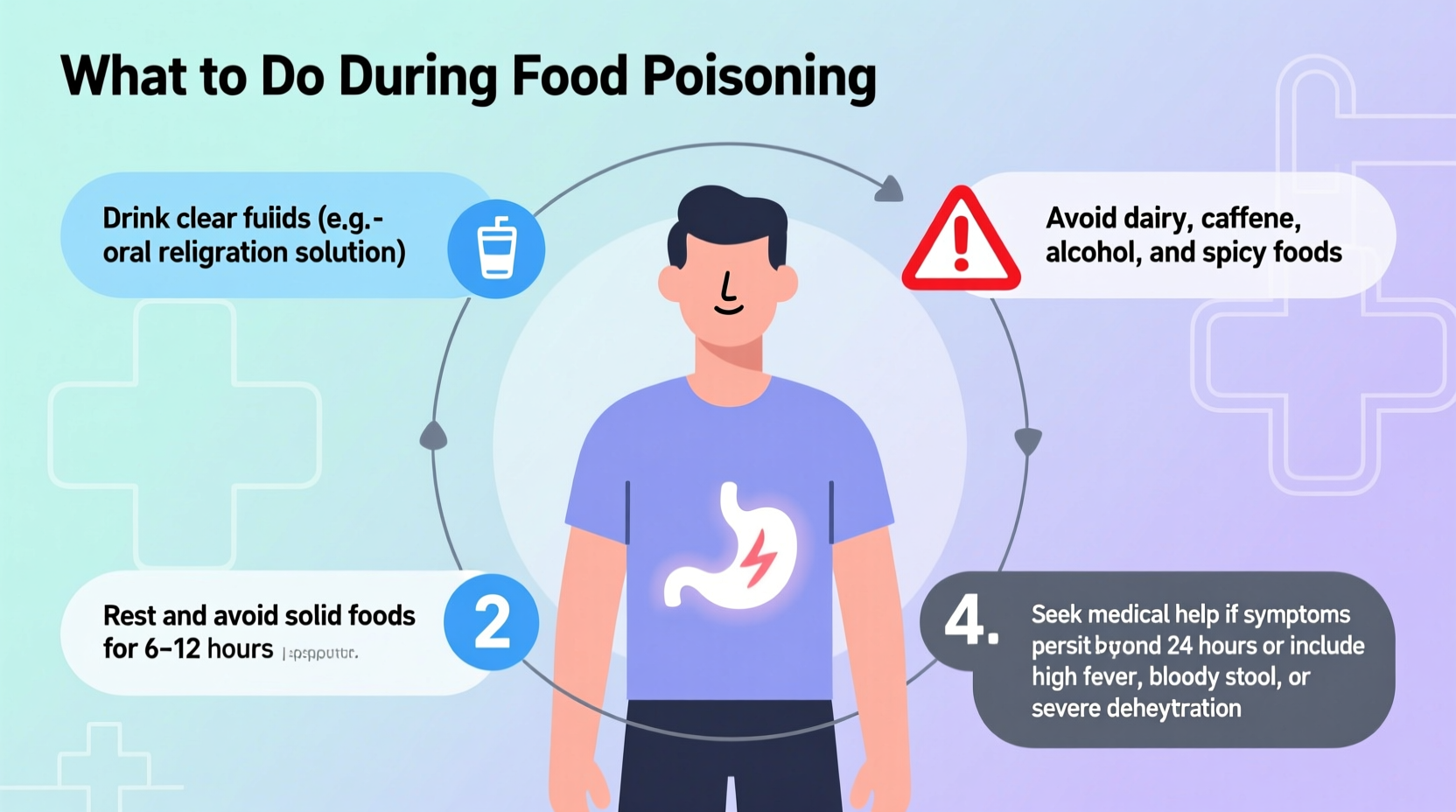Food poisoning strikes suddenly and can leave you feeling miserable within hours of eating contaminated food. Knowing exactly what to do for food poisoning makes all the difference in your recovery time and comfort level. This guide provides medically-reviewed steps to manage symptoms safely while recognizing when professional care becomes essential.
Immediate Actions: First 6 Hours
When food poisoning symptoms hit, your initial response determines your recovery trajectory. Follow these evidence-based steps:
- Stop all food consumption for 4-6 hours to let your digestive system rest (CDC recommends this initial fasting period)
- Sip clear fluids slowly - water, broth, or oral rehydration solutions (1-2 tablespoons every 5-10 minutes)
- Avoid anti-diarrheal medications during the first 24 hours unless directed by a doctor
- Don't induce vomiting - this can cause additional complications
- Rest completely - physical activity worsens symptoms
During this critical phase, your body is actively expelling harmful bacteria or toxins. For mild food poisoning treatment at home, proper hydration prevents complications more effectively than any medication.

Symptom Timeline: What to Expect Hour by Hour
Understanding the typical food poisoning progression timeline reduces anxiety and helps you recognize warning signs:
| Time After Exposure | Common Symptoms | Recommended Action |
|---|---|---|
| 1-6 hours | Sudden nausea, vomiting, stomach cramps | Begin fluid replacement protocol, rest |
| 6-24 hours | Diarrhea develops, possible fever | Introduce BRAT diet (bananas, rice, applesauce, toast) if able to keep fluids down |
| 24-72 hours | Symptoms peak then gradually improve | Gradually increase bland foods, continue hydration |
| 72+ hours | Persistent symptoms indicate complication | Seek medical evaluation immediately |
This food poisoning symptom timeline varies based on the contaminant type. According to the Centers for Disease Control and Prevention, norovirus typically causes symptoms within 12-48 hours, while Salmonella may take 6 hours to 6 days to manifest (CDC, 2023).
When Home Care Isn't Enough: Critical Warning Signs
Knowing when to see a doctor for food poisoning prevents life-threatening complications. Seek immediate medical attention if you experience:
- Signs of severe dehydration (dark urine, dizziness when standing, no urine for 8+ hours)
- Bloody or black stools
- Fever above 101.5°F (38.6°C)
- Vomiting lasting more than 2 days
- Diarrhea lasting beyond 72 hours
- Numbness, blurred vision, or muscle weakness
High-risk groups including infants, elderly adults, pregnant women, and immunocompromised individuals should contact healthcare providers at the first sign of symptoms. The Mayo Clinic emphasizes that food poisoning complications can develop rapidly in these populations (Mayo Clinic, 2024).
Recovery Protocol: Days 2-5
As symptoms begin improving, follow this medically-approved recovery protocol:
- Reintroduce fluids gradually - Start with ice chips, then progress to small sips of water or electrolyte solutions
- Begin BRAT diet once you can keep fluids down for 12 hours (bananas, rice, applesauce, toast)
- Avoid dairy, caffeine, alcohol, spicy foods, and fatty foods for 48-72 hours after symptoms resolve
- Gradually expand diet as tolerated - add boiled potatoes, crackers, oatmeal
- Continue hydration with electrolyte solutions for 3-5 days total
Proper food poisoning recovery steps prevent symptom recurrence. The FDA notes that rushing back to normal eating patterns extends recovery time by 40-60% in documented cases (FDA Food Safety, 2023).
Preventing Future Episodes
Understanding how to avoid food poisoning protects you and your family:
- Wash hands thoroughly before handling food and after bathroom use
- Cook meats to proper internal temperatures (use a food thermometer)
- Refrigerate leftovers within 2 hours (1 hour if temperature exceeds 90°F/32°C)
- Separate raw meats from other foods during storage and preparation
- Wash fruits and vegetables under running water before consumption
Implementing these food poisoning prevention strategies reduces risk by up to 90% according to World Health Organization food safety guidelines.
Common Misconceptions About Food Poisoning
Many food poisoning home remedies actually worsen symptoms. Avoid these dangerous myths:
- "Inducing vomiting helps" - This can cause esophageal damage and doesn't remove toxins already absorbed
- "Alcohol kills bacteria" - Alcohol dehydrates you further and stresses your liver
- "Starving speeds recovery" - Your body needs nutrients to heal; prolonged fasting weakens immunity
- "All food poisoning lasts 24 hours" - Many pathogens cause symptoms for 3-7 days
Trust evidence-based approaches over folk remedies when managing what to do if you have food poisoning.
How soon after eating contaminated food do symptoms appear?
Symptoms typically appear 1-6 hours for bacterial toxins, 6-72 hours for bacterial infections, and up to 4 weeks for some parasites. The CDC reports norovirus symptoms usually begin 12-48 hours after exposure.
Can you spread food poisoning to others?
Yes, many foodborne illnesses are contagious. Norovirus remains infectious for up to two weeks after symptoms end. Practice strict hand hygiene and avoid preparing food for others until 48 hours after symptoms resolve completely.
When can I return to work or school after food poisoning?
Stay home until you've been symptom-free for at least 24-48 hours. For food service workers, healthcare professionals, or those working with vulnerable populations, many health departments require 48-72 hours without symptoms before returning to work.
Are probiotics helpful for food poisoning recovery?
Research shows certain probiotics like Lactobacillus rhamnosus GG may shorten diarrhea duration by about one day when taken during recovery. However, they're not a treatment for active food poisoning and shouldn't replace hydration therapy.
How can I tell food poisoning from stomach flu?
Food poisoning typically features sudden onset of vomiting and diarrhea within hours of eating suspect food, often with stomach cramps. Stomach flu (viral gastroenteritis) usually includes additional symptoms like body aches, headache, and longer duration. Only lab tests can definitively distinguish between them.











 浙公网安备
33010002000092号
浙公网安备
33010002000092号 浙B2-20120091-4
浙B2-20120091-4